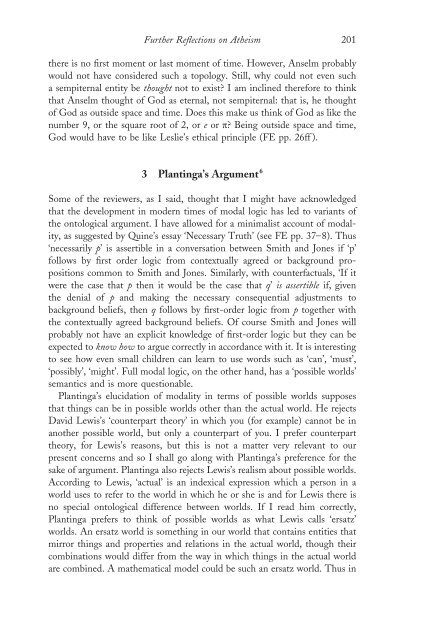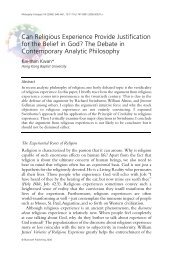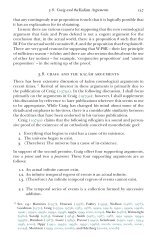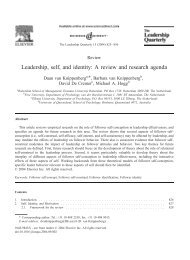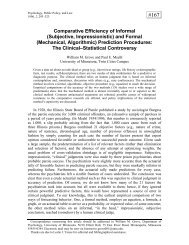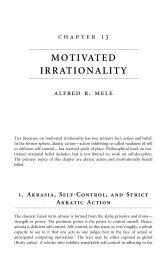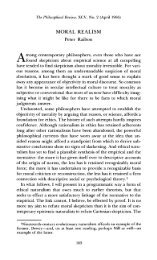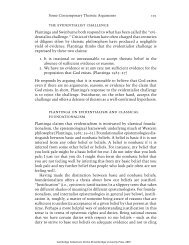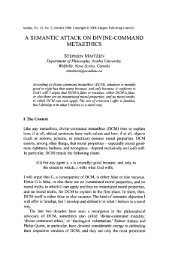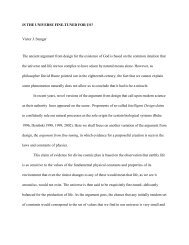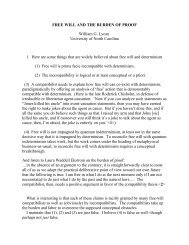Atheism and Theism JJ Haldane - Common Sense Atheism
Atheism and Theism JJ Haldane - Common Sense Atheism
Atheism and Theism JJ Haldane - Common Sense Atheism
Create successful ePaper yourself
Turn your PDF publications into a flip-book with our unique Google optimized e-Paper software.
Further Reflections on <strong>Atheism</strong> 201<br />
there is no first moment or last moment of time. However, Anselm probably<br />
would not have considered such a topology. Still, why could not even such<br />
a sempiternal entity be thought not to exist? I am inclined therefore to think<br />
that Anselm thought of God as eternal, not sempiternal: that is, he thought<br />
of God as outside space <strong>and</strong> time. Does this make us think of God as like the<br />
number 9, or the square root of 2, or e or π? Being outside space <strong>and</strong> time,<br />
God would have to be like Leslie’s ethical principle (FE pp. 26ff ).<br />
3 Plantinga’s Argument 6<br />
Some of the reviewers, as I said, thought that I might have acknowledged<br />
that the development in modern times of modal logic has led to variants of<br />
the ontological argument. I have allowed for a minimalist account of modality,<br />
as suggested by Quine’s essay ‘Necessary Truth’ (see FE pp. 37–8). Thus<br />
‘necessarily p’ is assertible in a conversation between Smith <strong>and</strong> Jones if ‘p’<br />
follows by first order logic from contextually agreed or background propositions<br />
common to Smith <strong>and</strong> Jones. Similarly, with counterfactuals, ‘If it<br />
were the case that p then it would be the case that q’ is assertible if, given<br />
the denial of p <strong>and</strong> making the necessary consequential adjustments to<br />
background beliefs, then q follows by first-order logic from p together with<br />
the contextually agreed background beliefs. Of course Smith <strong>and</strong> Jones will<br />
probably not have an explicit knowledge of first-order logic but they can be<br />
expected to know how to argue correctly in accordance with it. It is interesting<br />
to see how even small children can learn to use words such as ‘can’, ‘must’,<br />
‘possibly’, ‘might’. Full modal logic, on the other h<strong>and</strong>, has a ‘possible worlds’<br />
semantics <strong>and</strong> is more questionable.<br />
Plantinga’s elucidation of modality in terms of possible worlds supposes<br />
that things can be in possible worlds other than the actual world. He rejects<br />
David Lewis’s ‘counterpart theory’ in which you (for example) cannot be in<br />
another possible world, but only a counterpart of you. I prefer counterpart<br />
theory, for Lewis’s reasons, but this is not a matter very relevant to our<br />
present concerns <strong>and</strong> so I shall go along with Plantinga’s preference for the<br />
sake of argument. Plantinga also rejects Lewis’s realism about possible worlds.<br />
According to Lewis, ‘actual’ is an indexical expression which a person in a<br />
world uses to refer to the world in which he or she is <strong>and</strong> for Lewis there is<br />
no special ontological difference between worlds. If I read him correctly,<br />
Plantinga prefers to think of possible worlds as what Lewis calls ‘ersatz’<br />
worlds. An ersatz world is something in our world that contains entities that<br />
mirror things <strong>and</strong> properties <strong>and</strong> relations in the actual world, though their<br />
combinations would differ from the way in which things in the actual world<br />
are combined. A mathematical model could be such an ersatz world. Thus in


